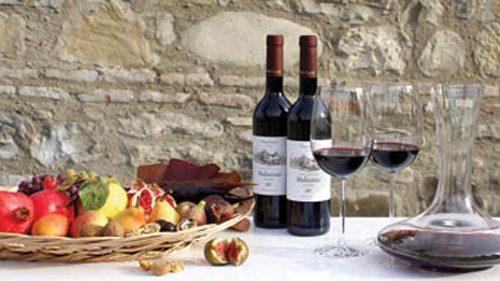
By Levan Kakochashvili
Many scientists believe that the cult of wine in Europe originated from Georgia. Thousands of years ago, people who inhabited the territory, which today we call Georgia,were familiar with the process of wine making from grape. Proof of this can be found in Xenophon’s (431 BC) and Strabo’s (II c. BC) works, while archaeological sources indicate the existence of winemaking in Georgia as far back as 8000 BC.
In the 4th century St. Nino, enlightener of Georgia, came to Georgia from Cappadocia with a grapevine cross twined into her hair. In the 9th century, at the Academy of Education, located in the old Georgian city of Ikalto (Kakheti), a winemaking faculty was founded.
The famous French traveler Jean Sharden visited Georgia in 1669, and in his memoirs noted that the best Kakhetian was being exported in significant quantities to the Armenian region and the Ispahan court (a city in Persia) at a cost of 8 Francs per pack. Hailing the quality of Georgian wine, he wrote: “... safe to say that nowhere people drink so much wine in such good quality as in Georgia”.
According to Jacques Francois Gamba, the French Consul in Tbilisi “…in Georgia everyone, including a worker and a prince, drank wine with average daily consumption of five bottles per resident”. While visiting the Georgian Prince Alexander Chavchavadze in 1820, Gamba spoke fondly about the Prince’s wine estate Chateau Zegaani in Kakheti region, and emphasized its similarity to the European architecture of the 19th century.
Michael Ballas, a well-known winemaking researcher in the 19th century, asserted that Saperavi is only good when grown in its homeland, Kakheti, as it loses its outstanding taste when harvested elsewhere.
In the late 19th century, 10,925 hectaresof vineyards in Kakheti were worth 2,000 Russian Rubles, a vast sum of money at the time. Back then, a teacher’s or doctor’s salary amounted to 10-15 Rubles and was considered to be a good income.
Famous wine guide and critic Robert Parker in 2004 made his list of predictions for what the global wine industry would look like in 2015. He asserted that wines made “without oak” would become popular, and “pure wine”, whose bouquets’ would not have impurities (caused by aging in oak) will gain a deserved position.
Wines “without oak” have been produced in Georgia for centuries: they are made in kvevri – red clay jars. Chateau Zegaani – the oldest winemaking estate in Kakheti - keeps 45 two-ton kvevris.
On December 4, 2013 UNESCO assigned the status of intangible cultural heritage to the method of winemaking in kvevri. It appears, therefore, that Parker’s prophecies are coming true.
© georgiatoday.ge






